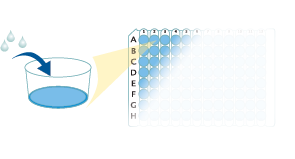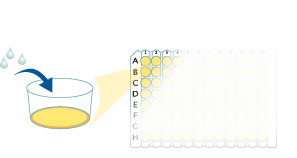Canine IL-6 Quantikine Kit Summary
Product Summary
Precision
Cell Culture Supernates, Serum, EDTA Plasma, Heparin Plasma
| Intra-Assay Precision | Inter-Assay Precision | |||||
|---|---|---|---|---|---|---|
| Sample | 1 | 2 | 3 | 1 | 2 | 3 |
| n | 20 | 20 | 20 | 67 | 65 | 66 |
| Mean (pg/mL) | 92.6 | 256 | 685 | 90.7 | 262 | 666 |
| Standard Deviation | 3.1 | 8.3 | 15.3 | 6.6 | 15.5 | 30.2 |
| CV% | 3.3 | 3.2 | 2.2 | 7.3 | 5.9 | 4.5 |
Recovery
The recovery of canine IL-6 spiked to three levels throughout the range of the assay in various matrices was evaluated.
| Sample Type | Average % Recovery | Range % |
|---|---|---|
| Cell Culture Supernates (n=6) | 94 | 87-103 |
| EDTA Plasma (n=4) | 97 | 91-103 |
| Heparin Plasma (n=4) | 92 | 83-100 |
| Serum (n=4) | 93 | 84-102 |
Linearity
Scientific Data
Product Datasheets
Preparation and Storage
Background: IL-6
Interleukin 6 (IL-6) is a pleiotropic, alpha -helical, 22-28 kDa phosphorylated and variably glycosylated cytokine that plays important roles in the acute phase reaction, inflammation, hematopoiesis, bone metabolism, and cancer progression (1-5). Mature canine IL-6 is 187 amino acids (aa) in length and shares 58%, 37%, 39%, and 76% aa sequence identity with human, mouse, rat, and feline IL-6, respectively. Cells known to express IL-6 include CD8+ T cells, fibroblasts, synoviocytes, adipocytes, osteoblasts, megakaryocytes, endothelial cells (under the influence of endothelins), sympathetic neurons, cerebral cortex neurons, adrenal medulla chromaffin cells, retinal pigment cells, mast cells, keratinocytes, Langerhans cells, fetal and adult astrocytes, neutrophils, monocytes, eosinophils, colonic epithelial cells, B1 B cells and pancreatic islet beta cells (2, 6-28). IL-6 production is generally correlated with cell activation and is normally kept in control by glucocorticoids, catecholamines, and secondary sex steroids (2). Normal human circulating IL-6 is in the 1 pg/mL range, with slight elevations during the menstrual cycle, modest elevations in certain cancers, and large elevations after surgery (29-33).
Assay Procedure
Refer to the product- Prepare all reagents, standard dilutions, and samples as directed in the product insert.
- Remove excess microplate strips from the plate frame, return them to the foil pouch containing the desiccant pack, and reseal.
- Add 50 µL of Assay Diluent to each well.
- Add 100 µL of Standard, Control, or sample to each well. Cover with a plate sealer, and incubate at room temperature for 2 hours on an orbital microplate shaker.
- Aspirate each well and wash, repeating the process 4 times for a total of 5 washes.
- Add 200 µL of Conjugate to each well. Cover with a new plate sealer, and incubate at room temperature for 2 hours on the shaker.
- Aspirate and wash 5 times.
- Add 120 µL Substrate Solution to each well. Incubate at room temperature on the benchtop for 30 minutes. PROTECT FROM LIGHT.
- Add 120 µL of Stop Solution to each well. Gently tap the plate to ensure thorough mixing. Read at 450 nm within 30 minutes. Set wavelength correction to 540 nm or 570 nm.





Citations for Canine IL-6 Quantikine Kit
R&D Systems personnel manually curate a database that contains references using R&D Systems products. The data collected includes not only links to publications in PubMed, but also provides information about sample types, species, and experimental conditions.
17
Citations: Showing 1 - 10
Filter your results:
Filter by:
-
Translation of immunomodulatory therapy to treat chronic heart failure: Preclinical studies to first in human
Authors: HD Humes, KD Aaronson, DA Buffington, HN Sabbah, AJ Westover, LT Yessayan, B Szamosfalv, FD Pagani
PLoS ONE, 2023-04-06;18(4):e0273138.
Species: Canine
Sample Types: Serum
-
Translation of immunomodulatory therapy to treat chronic heart failure: Preclinical studies to first in human
Authors: HD Humes, KD Aaronson, DA Buffington, HN Sabbah, AJ Westover, LT Yessayan, B Szamosfalv, FD Pagani
PLoS ONE, 2023;18(4):e0273138.
Species: Canine
Sample Types: Serum
-
Molecular Characterization of CF33 Canine Cell Line and Evaluation of Its Ability to Respond against Infective Stressors in Sight of Anticancer Approaches
Authors: E Razzuoli, CG De Ciucis, B Chirullo, K Varello, R Zoccola, L Guardone, P Petrucci, D Rubini, E Bozzetta, M Goria, F Fruscione, P Modesto
Veterinary sciences, 2022-10-02;9(10):.
Species: Canine
Sample Types: Cell Culture Supernates
-
Mycobacterium intracellulare induces a Th17 immune response via M1-like macrophage polarization in canine peripheral blood mononuclear cells
Authors: S Kim, YS Hyun, HT Park, MK Shin, HS Yoo
Scientific Reports, 2022-07-12;12(1):11818.
Species: Canine
Sample Types: Cell Culture Supernates
-
Interleukin-6 and thrombopoietin concentrations in dogs with carcinoma with and without thrombocytosis
Authors: A Cheney, AD Woolcock, A Mukhopadhy, D Knapp, GE Moore
Journal of veterinary internal medicine, 2021-12-08;0(0):.
Species: Canine
Sample Types: Serum
-
Prospective evaluation of 5 urinary biomarkers as predictors of acute kidney injury in nonazotemic, hospitalized dogs
Authors: R Nivy, N Chaim, E Hanael, GA Sutton, Y Bruchim, I Aroch, G Segev
Journal of veterinary internal medicine, 2021-11-05;0(0):.
Species: Canine
Sample Types: Urine
-
Effect of Cannabidiol (CBD) on Canine Inflammatory Response: An Ex Vivo Study on LPS Stimulated Whole Blood
Authors: E Gugliandol, P Licata, AF Peritore, R Siracusa, R D'Amico, M Cordaro, R Fusco, D Impellizze, R Di Paola, S Cuzzocrea, R Crupi, CD Interlandi
Veterinary sciences, 2021-09-04;8(9):.
Species: Canine
Sample Types: Whole Blood
-
Inflammation and its association with oxidative stress in dogs with heart failure
Authors: A Nemec Svet, B Verk, N ?ebulj-Kad, J Salobir, V Rezar, A Domanjko P
Bmc Veterinary Research, 2021-04-26;17(1):176.
Species: Canine
Sample Types: Serum
-
Effect of modified ultrafiltration on cytokines and hemoconcentration in dogs undergoing cardiopulmonary bypass
Authors: H Suzuki, N Oshima, T Watari
J Vet Med Sci, 2020-10-05;0(0):.
Species: Canine
Sample Types: Plasma
-
Hematologic and serologic status of military working dogs given standard diet containing natural botanical supplements
Authors: E Lee, JH Choi, HJ Jeong, SG Hwang, S Lee, JW Oh
Toxicol Rep, 2018-03-08;5(0):343-347.
Species: Canine
Sample Types: Serum
-
Evaluation of potential serum biomarkers of hepatic fibrosis and necroinflammatory activity in dogs with liver disease
Authors: C Raghu, J Ekena, JM Cullen, CB Webb, LA Trepanier
J. Vet. Intern. Med., 2018-02-27;0(0):.
Species: Canine
Sample Types: Serum
-
Comparison of postoperative pain and inflammation reaction in dogs undergoing preventive laparoscopic-assisted and incisional gastropexy
Authors: T Haraguchi, S Kimura, H Itoh, S Nishikawa, M Hiyama, K Tani, T Iseri, Y Itoh, M Nakaichi, Y Taura, K Itamoto
J. Vet. Med. Sci., 2017-07-17;0(0):.
Species: Canine
Sample Types: Serum
-
Higher neonatal growth rate and body condition score at 7�months are predictive factors of obesity in adult female Beagle dogs
Authors: L Leclerc, C Thorin, J Flanagan, V Biourge, S Serisier, P Nguyen
BMC Vet. Res., 2017-04-13;13(1):104.
Species: Canine
Sample Types: Plasma
-
Continuous venovenous hemofiltration decreases mortality and ameliorates acute lung injury in canine model of severe salt water drowning
Authors: J Chen, G Chen, D Xiao, W Peng, G Yu, Y Lin, F Zheng
Scand J Trauma Resusc Emerg Med, 2016-03-31;24(1):40.
Species: Canine
Sample Types: Plasma
-
Canine model of ischemic stroke with permanent middle cerebral artery occlusion: clinical features, magnetic resonance imaging, histopathology, and immunohistochemistry.
Authors: Jeon J, Jung H, Jang H, Moon J, Park K, Lee H, Lim H, Sur J, Kang B, Ha J, Jung D
J Vet Sci, 2014-09-30;16(1):75-85.
Species: Canine
Sample Types: CSF
-
Evaluation of the effects of methadone and tramadol on postoperative analgesia and serum interleukin-6 in dogs undergoing orthopaedic surgery.
Authors: Cardozo L, Cotes L, Kahvegian M, Rizzo M, Otsuki D, Ferrigno C, Fantoni D
BMC Vet Res, 2014-09-06;10(0):194.
Species: Canine
Sample Types: Serum
-
Human Flt3L generates dendritic cells from canine peripheral blood precursors: implications for a dog glioma clinical trial.
Authors: Xiong W, Candolfi M, Liu C
PLoS ONE, 2010-06-11;5(6):e11074.
Species: Canine
Sample Types: Cell Culture Supernates
FAQs
-
What is the normal appearance of Assay Diluent RD1-75?
Assay Diluent RD1-75 contains high concentrations of additives and typically has a very cloudy, brown appearance. It is recommended to mix this diluent well before and during use.
Supplemental ELISA Products
Reviews for Canine IL-6 Quantikine Kit
Average Rating: 4.5 (Based on 2 Reviews)
Have you used Canine IL-6 Quantikine Kit?
Submit a review and receive an Amazon gift card.
$25/€18/£15/$25CAN/¥75 Yuan/¥2500 Yen for a review with an image
$10/€7/£6/$10 CAD/¥70 Yuan/¥1110 Yen for a review without an image
Filter by:
















